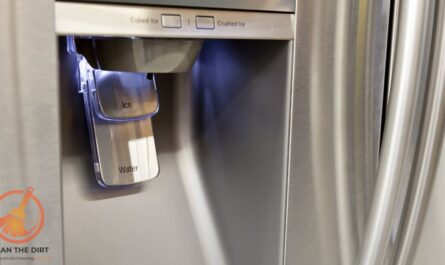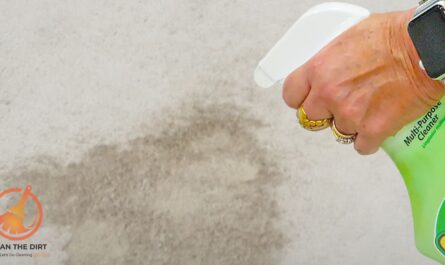Table of Contents
Introduction
Brass hardware adds a touch of timeless charm to any space, whether it’s the vintage handles on an old dresser, classic door knockers, or decorative fixtures in your kitchen. But as beautiful as brass is, it doesn’t stay gleaming forever. Exposure to air, moisture, and regular use can cause it to lose its sheen and acquire a dull or greenish patina over time.
That’s why knowing how to clean brass hardware is essential if you want to keep your home or accessories looking polished and well-maintained. Here the good news is that You don’t require costly goods or expert assistance. With the right knowledge and a few household ingredients, you can restore your brass to its original luster in no time.
In this guide, we’ll walk you through everything you need to know—not just how to clean brass hardware, but also how to clean brass items, brass jewelry, brass candlesticks, and even how to clean brass with vinegar. Whether you’re a seasoned DIYer or a first-timer, this article will make brass cleaning simple and effective.
If you love keeping every part of your home in top shape, you might also enjoy our guide on How to Clean Wool Rug? Preserve Softness and Vibrant Colors.
Understanding Brass: What You’re Working With
Before starting the brass hardware cleaning procedure. It’s important to first understand what kind of brass you’re dealing with. Not all brass is created equal, and using the wrong cleaning method could do more harm than good.
Solid Brass vs Brass-Plated
Brass items generally fall into two categories: A copper-zinc alloy makes up solid brass, but brass-plated objects typically have a thin coating of brass on top of another metal, such as zinc or steel.
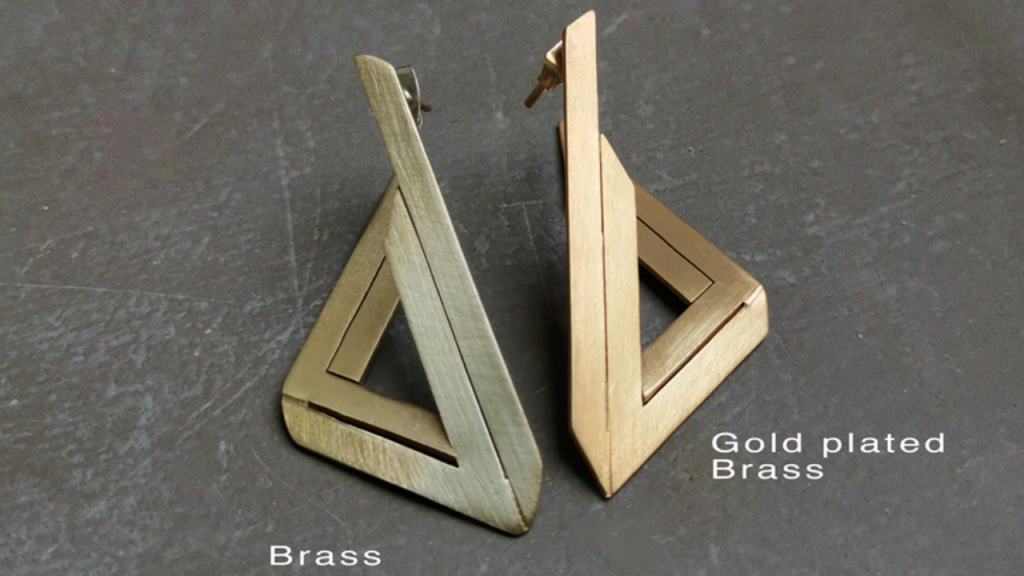
How can you tell the difference? Try this quick test:
- Press a tiny magnet onto your object.
- If the magnet does not adhere, solid brass is probably used in its construction.
- You’re most likely dealing with brass-plated metal if the magnet adheres.
This distinction matters because some stronger cleaners or abrasive methods that work well on solid brass can actually damage or wear down the thin brass coating on plated items.
Check for Lacquer Coating
Some brass hardware comes with a protective lacquer finish to prevent tarnishing. You can usually tell by the glossy, sealed look of the surface. If it’s lacquered, cleaning methods should be extra gentle to avoid stripping the coating.
Why This Matters
Understanding the type of brass you’re working with helps you choose the safest and most effective method for cleaning. Whether you’re looking to polish an antique door handle or figuring out how to clean brass jewelry, the first step is knowing your material.
Now that you’ve identified your brass type, let’s move on to the actual process of how to clean brass hardware properly and bring back its brilliant shine.
How to Clean Brass Hardware?
Brass hardware is often the first thing people notice on doors, drawers, and cabinets. When it’s clean and polished, it adds a warm, elegant touch to your space. But when it’s dull or tarnished, it can drag down the entire look of a room. Fortunately, learning how to clean brass hardware is simple, and you can do it with items you already have at home.
How to Clean Brass Hardware? A Step-by-Step Guide
1. Remove the Hardware (If Possible)
If you’re able to unscrew the brass hardware from doors or furniture, it’s best to clean it separately. This gives you more control and keeps surrounding surfaces safe from any cleaning solutions.
2. Prepare a Gentle Cleaning Paste
Here’s a simple homemade cleaner to get you started,
- Equal amounts of flour, white vinegar, and salt are combined to form a paste.
- This combination is surprisingly effective for those looking to learn how to clean brass hardware without harsh chemicals.
3. Apply the Paste and Let It Sit
Utilizing a sponge or soft cloth, apply the paste to the hardware. Be sure to cover all tarnished areasGive it 10 to 15 minutes to sit so it can work its magic.
4. Scrub Gently
Use a soft toothbrush or towel to gently scrub the surface. The item is solid brass or brass-plated.
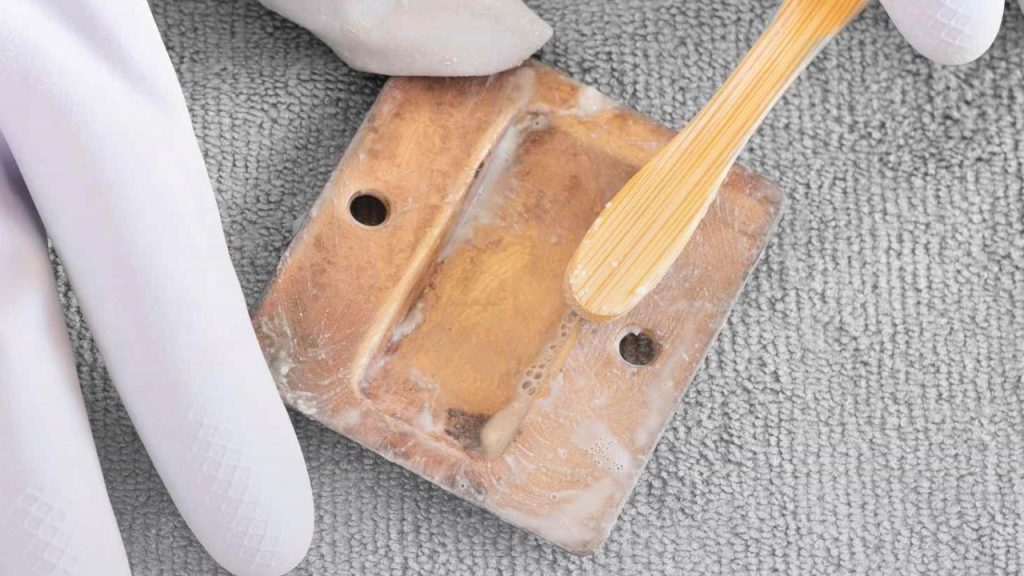
5. Rinse and Dry Thoroughly
To remove the paste, rinse the hardware with warm water and gently dry with a gentle towel. Moisture is the deadliest enemy of brass when it comes to tarnishing.
6. Optional: Polish for Extra Shine
If you want your hardware to really shine, you can apply a small amount of brass polish after.
Maintaining Clean Brass Hardware
Once you’ve learned how to clean brass hardware, regular maintenance becomes easy. Use a dry towel to wipe it clean once a week to remove any dust or grease. For areas with high moisture, like bathrooms, consider applying a thin layer of wax to act as a moisture barrier.
just like maintaining other household items, such as your fridge accessories. Be sure to check out our article on How to Clean a Refrigerator Water Dispenser? for a sparkling clean kitchen experience.
When to Avoid DIY Methods
If you have ancient or valuable brass hardware, you should consult an expert. Cleaning too thoroughly can reduce its value or result in permanent harm.
How to Clean Brass Jewelry
Brass jewelry has a warm, golden tone that makes it a popular and affordable alternative to gold. However, it may eventually tarnish or lose its shine due to exposure to perspiration, air, fragrances, and moisture. If you’re wondering how to clean brass jewelry without damaging it, don’t worry—it’s easier than you think, and you don’t need any fancy products.
Why Brass Jewelry Tarnishes
Brass is a mix of copper and zinc, and both of these metals naturally oxidize over time. That’s what causes the greenish or dull brown layer on your favorite ring or bracelet. But the good news is that cleaning brass jewelry doesn’t require any harsh chemicals or expensive tools.
Gentle Cleaning Method for Everyday Tarnish
Here’s a simple and secure method to bring back the luster of your jewelry:
What You’ll Need:
- A bowl of warm water
- Mild dish soap
- A soft toothbrush or cloth
- A microfiber towel
Steps:
- For five to ten minutes, soak the jewelry in warm, soapy water.
- Gently scrub with a soft toothbrush, focusing on detailed areas where dirt builds up.
- Rinse well and use a microfiber towel to pat dry.
- Buff lightly to bring back the shine.
This method works well for lightly tarnished pieces or regular maintenance.
Deep Cleaning With Lemon Juice and Baking Soda
For more stubborn tarnish, here’s a natural method:
- Fill a small basin with lemon juice.
- A thick paste should be produced by adding enough baking soda.
- Using a towel or your fingertips, gently apply it to the jewelry. Rinse and dry well after letting it sit for a few minutes.
This is one of the most effective DIY tricks if you’re trying to figure out how to clean brass jewelry that’s heavily tarnished.
What to Avoid
- Never use abrasive materials like steel wool.
- Steer clear of harsh chemicals and cleaners with alcohol bases as they can harm the surface.
- Don’t soak pieces that have glued-in stones or are hollow or plated.
Keep It Shining Longer
Once you’ve learned how to clean brass jewelry, regular care helps maintain its beauty:
- Store it in a dry place.
- Keep it in a fabric pouch or airtight container.
- Wipe it with a dry cloth after wearing to remove oils and moisture.
How to Clean Brass Candlesticks
Brass candlesticks are timeless and elegant. Whether you use them for dinner parties or as antique decor, their golden glow adds warmth to any room. But over time, they can lose their shine or get covered in wax and tarnish. If you’re wondering how to clean brass candlesticks without damaging them, here’s a safe and simple guide.
Step 1: Remove Old Wax
Before focusing on tarnish, start by getting rid of leftover candle wax:
- For approximately half an hour, place the candlesticks in the freezer.
- Once the wax hardens, gently chip it off with a wooden or plastic tool (never metal—metal can scratch the brass).
- Use a gentle towel to wipe up any leftovers.
Step 2: Identify If They’re Lacquered
A protective lacquer coating is included with certain brass candlesticks. If they look shiny and feel smooth, they might be lacquered, in which case harsh cleaners or abrasives can damage the finish. Only use water and mild soap on lacquered items
Step 3: Clean Using Natural Ingredients
For uncoated candlesticks, here’s a tried-and-true method that’s both gentle and effective:
You’ll need:
- 1 tablespoon of salt
- 1 tablespoon of flour
- 1 tablespoon of white vinegar

Instructions:
- Mix these ingredients into a thick paste.
- Using a gentle cloth, rub it onto the brass candlesticks.
- Let it sit for 10–15 minutes.
- Use a fresh towel to pat dry after rinsing with warm water.
This is a great natural method if you’re looking into how to clean brass candlesticks without chemicals.
Step 4: Polish for Extra Shine
Use a microfiber cloth to dab on some olive oil or even a tiny bit of brass polish after washing. This not only gives a shine but also creates a light barrier against tarnishing.
Bonus Tip: Prevent Future Tarnish
- Store candlesticks in a dry area.
- Avoid handling them too often, as skin oils can speed up tarnishing.
- Wrap them in cloth or tissue paper if you’re storing them long-term.
Now that you know how to clean brass candlesticks, you can keep them glowing on your mantel, dining table, or display shelf all year long.
How to Clean Brass Hardware? Try This Simple Vinegar Method
If you’re looking for a powerful yet natural way to restore the shine to your brass items, vinegar is your best friend. Many people ask how to clean brass with vinegar because it’s inexpensive, easy to find, and surprisingly effective. Whether you’re dealing with brass hardware, jewelry, or candlesticks, vinegar can break down tarnish without damaging the metal—when used correctly.
Why Vinegar Works
Vinegar is acidic, which helps it dissolve oxidation (the green or dark layer that forms on brass over time). When combined with other gentle ingredients like salt or flour, it becomes a potent brass-cleaning paste.
Method 1: Vinegar and Salt Paste
This method is great for stubborn tarnish.
You’ll need:
- 1 tablespoon of salt
- ½ cup of white vinegar
- Enough flour to make a paste
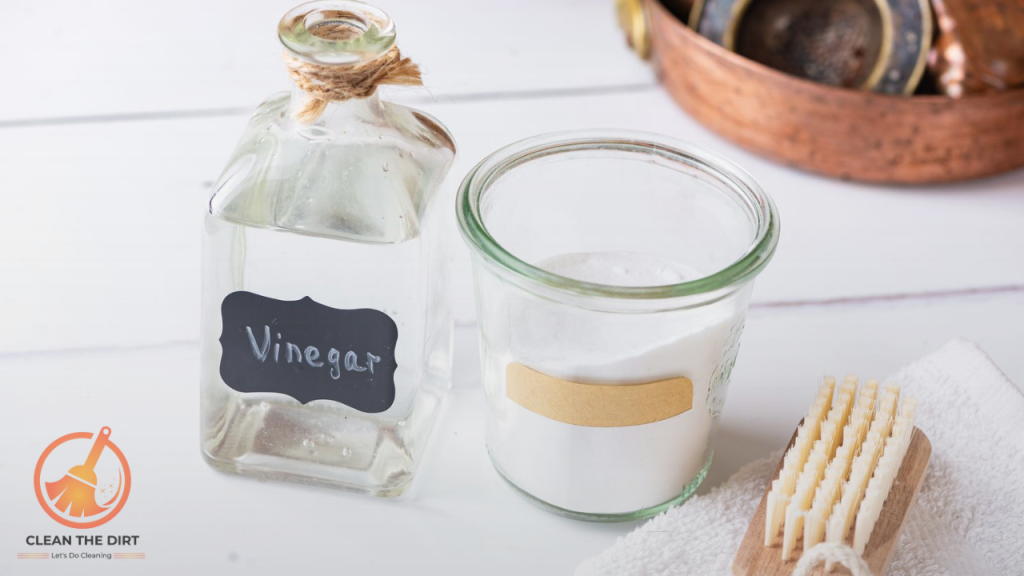
Instructions:
- Mix vinegar and salt in a bowl.
- Gradually add flour until a thick, spreadable dough is formed.
- Rub the paste onto the brass object with your fingers or a cloth.
- Depending on how tarnished it is, let the piece sit for 15 to 30 minutes.
- Use warm water to rinse well, then pat dry with a gentle cloth.
Use this method whenever someone asks you how to clean brass with vinegar safely and naturally.
Method 2: Soaking Smaller Brass Items
For small items like brass jewelry or knobs, a soak might be more effective.
Steps:
- In a basin, combine 1 part vinegar with 1 part warm water.
- Add a teaspoon of salt and stir.
- Drop the brass item and let it soak for 10–15 minutes.
- Use a soft brush, like an old toothbrush, to gently remove tarnish.
- Rinse and dry completely.
This method is ideal if you’re learning how to clean brass items quickly and without much scrubbing.
Precautions When Using Vinegar
- Do not use vinegar on brass-plated items—it can strip the thin coating.
- Always test a small area first if you’re unsure about how your item will react.
- Don’t let the paste dry completely, as that can make it harder to remove.
Finishing Touches
Once cleaned, consider rubbing a small amount of olive oil or mineral oil onto the surface. This can help prevent future tarnish and keep your brass items shining longer.
Common Mistakes to Avoid When Cleaning Brass
When learning how to clean brass hardware, jewelry, or decor, it’s easy to make mistakes that can do more harm than good. To keep your brass items shining and scratch-free, here are some common cleaning pitfalls to steer clear of:
1. Using Harsh Abrasives
It may be tempting to use steel wool or abrasive scrubbers to remove tarnish quickly, but this can permanently scratch the brass surface. Always use a mild sponge or a soft cloth.
2. Skipping the Test Spot
Never apply any cleaning solution—natural or chemical—without testing it first on a small, hidden area. This is especially important when you’re using homemade mixtures like vinegar and salt.
3. Assuming All Brass Is Solid
Some items are brass-plated rather than solid brass. Using strong acids or scrubbing too hard can strip the thin brass layer and expose the base metal underneath. When in doubt, clean plated items with mild soap and water only.
4. Letting Cleaners Sit Too Long
The brass may get dull or discolored if vinegar or other cleaning pastes are left on it for an extended period. To prevent damage, set a timer and rinse right away.
5. Neglecting to Dry Thoroughly
Moisture over time can lead to more tarnish and water stains. Always use a gentle cloth to properly dry your brass after cleaning. By avoiding these common mistakes, you’ll preserve the beauty and integrity of your items—and truly master how to clean brass hardware and more, the right way.
How Often Should You Clean Brass?
One of the most commonly requested questions is how often to polish brass. The answer depends on a few factors like where the item is used and whether it’s exposed to air, moisture, or touch.
General Rule of Thumb
- For decorative brass items like candlesticks or frames: Clean every 3–6 months, or whenever they look dull or tarnished.
- For functional brass hardware like doorknobs, drawer pulls, or faucets: Wipe them down monthly to remove fingerprints and dirt. Deep clean every 2–3 months.
- For brass jewelry that’s worn regularly: Clean lightly every few weeks, and give it a deeper clean monthly to maintain shine.
Preventive Care Tips
- Wipe brass surfaces regularly with a dry cloth to remove dust and oils.
- After washing, lightly coat with mineral oil or beeswax to prevent further tarnish.
- To prevent oxidation, keep brass jewelry in sealed containers.
Staying on top of regular cleaning not only keeps your items looking great but also makes the job easier each time. Once you’ve learned how to clean brass hardware and other items properly, a consistent routine becomes second nature.
Conclusion
In conclusion, learning how to clean brass the right way is a valuable skill that helps preserve the beauty and longevity of your treasured brass items. Whether you’re caring for brass hardware, jewelry, candlesticks, or other decor, knowing the right methods and avoiding common mistakes ensures that your brass pieces maintain their luster and charm for years to come.
From using natural solutions like vinegar to gentle polishing techniques, there are multiple ways to restore your brass’s shine without damaging it. Regular care, such as wiping down items and storing them properly, can go a long way in preventing tarnish from building up.
Remember, how to clean brass jewelry or any brass item is all about being gentle, using the right tools, and taking preventive measures to avoid future tarnish. With a bit of attention and the right methods, you can keep your brass collection looking as stunning as the day you bought it.
Now that you know how to properly clean your brass, you can confidently maintain your items with ease. Happy cleaning!
For more expert cleaning advice, don’t miss our detailed guides on How to Clean Wool Rug? and How to Clean Refrigerator Water Dispenser?—perfect reads to complement your cleaning routine.
This table breaks down popular brass cleaning methods, highlighting what each is best for along with their advantages and drawbacks. It’s a handy guide to help you choose the safest and most effective way to clean your brass items.
| Cleaning Method | Best For | Pros | Cons |
|---|
| Vinegar and Salt | Heavily tarnished brass hardware | Natural, strong tarnish remover | May harm brass-plated surfaces |
| Lemon and Baking Soda | Jewelry, mild tarnish | Gentle, safe, eco-friendly | Requires more effort and rubbing |
| Commercial Brass Polish | Solid brass needing quick shine | Solid brass needing a quick shine | Chemical-based, not always eco-friendly |
| Toothpaste (non-gel) | Small brass jewelry | Easily available, gentle abrasive | Not for large or deeply tarnished items |
| Ketchup | Decorative pieces, mild tarnish | Natural, acidic, easy to apply | May leave odor, not strong for heavy tarnish |
| Soap and Water | Brass-plated or delicate items | Safe and gentle | Doesn’t remove deep tarnish |
Frequently Asked Questions (FAQs) for How to Clean Brass Hardware?
1. What Is the Best Way to Clean Brass Hardware at Home?
The best way to clean brass hardware at home is by using natural solutions like vinegar and salt or lemon and baking soda. These methods are effective, affordable, and safe for regular use.
2. Can I Use Vinegar to Clean All Brass Items?
Vinegar works well on solid brass but should be avoided on brass-plated items as it may cause damage. Always test a small area first to be safe.
3. How Do I Know If My Brass Hardware Is Solid or Brass-Plated?
Check with a magnet—solid brass is not magnetic. Also, inspect the surface; solid brass has a uniform color, while brass-plated items may show signs of peeling or fading.
4. How Often Should I Clean Brass Hardware?
For daily-use hardware, clean every 2–3 months. For decorative items, every 4–6 months is enough to maintain their shine and prevent tarnish.

